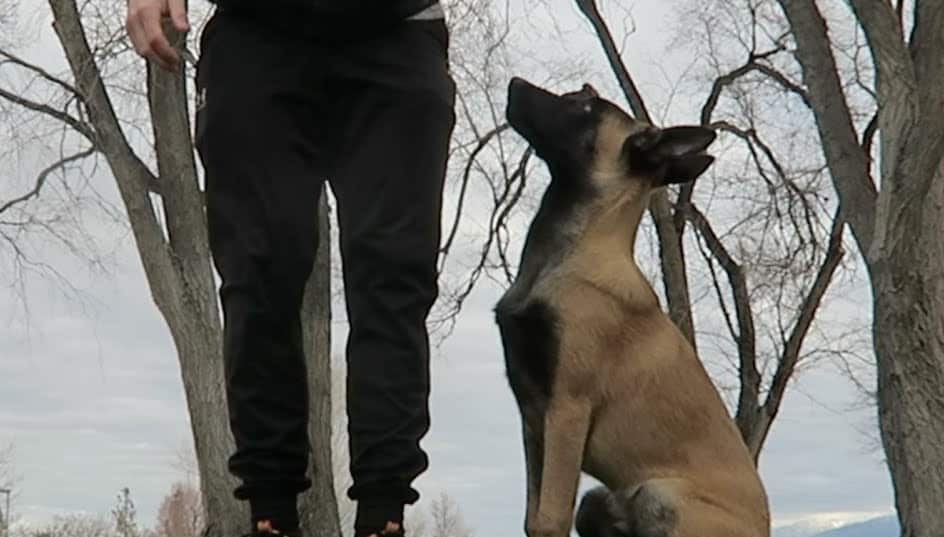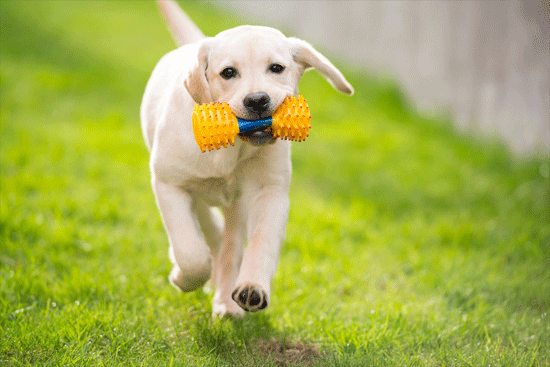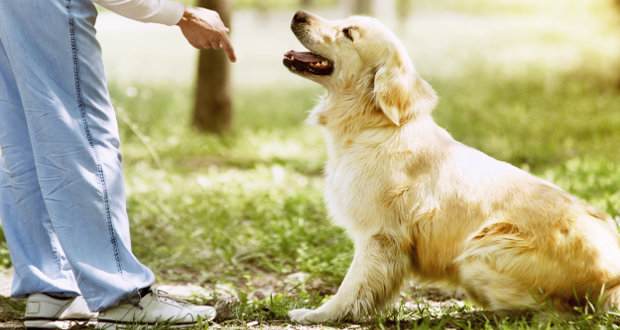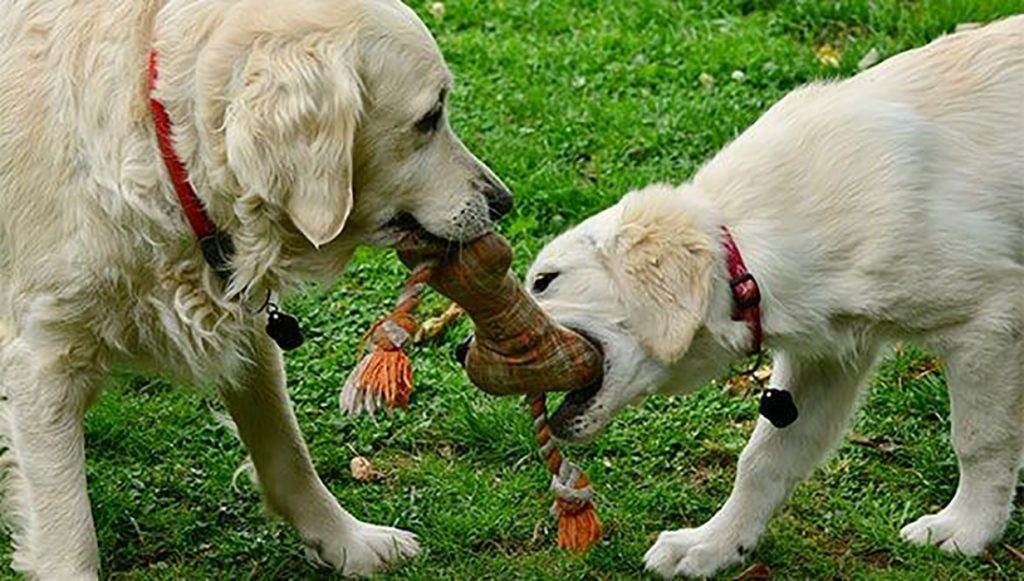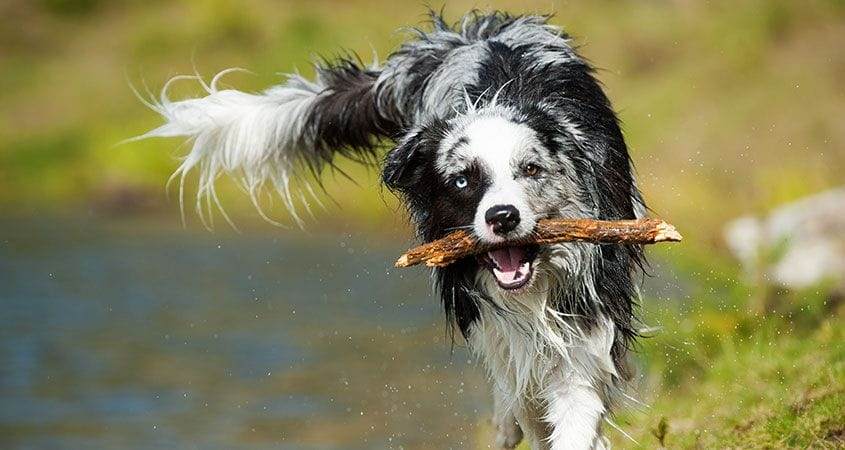The key points when training a dog to walk on leash without pulling are to use barriers, jump bars, handle distractions and staying consistent. With time, you will notice that the habit of pulling the leash is going away.
Leash skills should be taught to every dog, no matter size or age. Training a dog to walk on a leash without pulling might certainly appear to be a difficult task to undertake for a lot of individuals, especially if they are conducting such activity for the very first time.
It can definitely be challenging when the adequate strategies are not implemented, ones that encourage a dog to stop when you stop, turn when you turn, and continue to be by your side at all times.
Dogs are very smart animals; thus, they just need their owners to train them in a way that they can comprehend what is expected.
Training your dog to walk beside you can definitely come in handy in more than one aspect, particularly if you like engaging in different activities outside and cannot count on a dog sitter to come to the rescue every time.
In this article, I’m going to show you how to teach your dog to walk calmly on a loose leash. I will give some exercises which can be done at home. Then I will increase the difficulty with tough distractions, like other dogs.
Off-Leash Hazards
When a dog is not on a leash, there is no way to guarantee his safety. There have been numerous times when off-leash dogs have been impacted by vehicles or been within reach of a dangerous animal. In order to keep your dog safe at all times when outdoors, a leash is a must.
When your dog is indoors, the leash can be placed aside, but there might be a possibility of him escaping when the front or back door opens. In this instance, when training and management have been involved, the risks that he might face would be greatly minimized.
The dog would be used to being by your side, so not being would confuse him and would more than like make him want to go back home.
Best Time to Train Dog
There are many veterinarians who have suggested that the best time to train a dog is when he is hungry. Your dog would be motivated by hunger. Of course, once the training has been performed, you should provide him his meal.
What Is Needed to Begin Training?
Dog Pulls on Leash and Tried Everything?
There are several elements that can discourage a dog from pulling on a leash. A head collar or front-attachment harness are two solutions. Now, these elements are not meant to be utilized at all times. They should only be integrated when training is taking place.
Contrary to what many dog owners would believe, these two methods are very safe and quite easy. After putting one of these on your dog, training him to remain by your side will become easier.
The two things that are really important when it comes to training any dog are:
- Clarity
- Consistency
How to Leash Train a Dog That Won’t Walk
#1 Reward When Leash is Loose
I make sure that the clip of his leash is hanging down. That really shows that there is no tension on his leash. This is the only time that I’ll reward him.
I’ll never reward him when that clip is up or that leash is tight. This is because I don’t want to create any confusion for him. So that it’s really apparent that when he’s on a loose leash is when he’s being rewarded. So that little hack is a good one for you to keep in mind.
Pay attention to the clip of the leash. And only reward your dog when that clip is hanging down.
In case you want to move away from the training with love and you can devote time then do read our article on training dogs without treats and force.
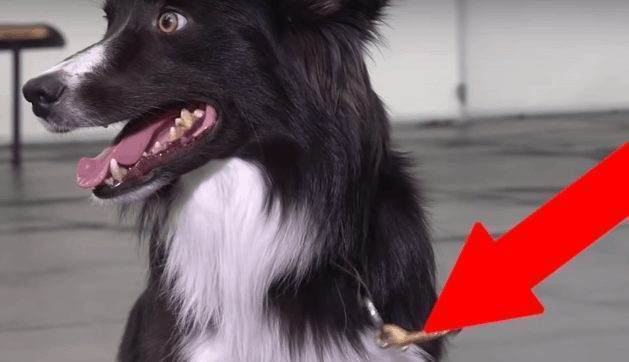
#2 How to Encourage Dog to Walk Beside You
One of the simplest ways that can be of great help to aid a dog learn to walk without pulling is to stop moving forward when the pulling starts to take place.
Reward your dog for being obedient. You should provide him with treats every time he walks by your side for a while. If your dog tends to dislike food treats, then you could always reward him with a toy.
There are numerous individuals who have undertaken the aforementioned suggestion, and from doing so, now, they do not have to worry that their dog will become frustrated when a leash is placed around their neck. Not only will the dog no longer be frustrated, but also the owner.
It can definitely be a hassle for any dog owner to go outside with an untrained dog. There is not much that an owner will be able to get done, hence why numerous veterinarians recommend the implementation of training.
Training takes practice and the implementation of adequate strategies.
If possible, you should utilize your backyard or a public place that is nearby to train. You should use a leash that is no more than 20 feet long. There are a lot of dog owners who commit the wrongdoing of opting for a leash that is longer.
This decision causes a variety of different issues in the long run. One of them is that you will not be able to train your dog as you would expect. There will too much space between you two. He needs to be restrained to some extent in the beginning.
It is vital for you to decide the side that your dog is going to walk, either right or left. The left side is the most common. Once you choose the side, do not change it, as this will just take you and your dog several steps backward in your training journey.
He would have to get used to the other side, which could cause him to become confused and you quite frustrated because you will have to begin training him from scratch. You certainly want to stop this from taking place.
Begin to walk randomly and briskly around your yard, or public place. This is a very important strategy to implement because it will help your dog become aware that you are in charge and that he has to stop whenever you do.
Your dog will feel that you are the one in the driver seat, and he is just there for the ride you opt to undertake with him.
#3 Best Solution for Dog Pulling on Leash – Use a Barrier
Another trick is to use a barrier to keep your dog in at your side. For dogs who love to swing out or maybe lurch out to the end of their leash away from you, pick a barrier. It could be a hallway in your house.
Or maybe it’s an exterior wall or maybe you set up a bunch of chairs in a row. The idea is to make sure that your dog has to stay a little bit closer to you.
For those of you with the smaller dogs, this is really going to create a clear line. A clear path for them to maintain that position. For those of you guys with the bigger dogs, this is going to be a lot easier because it’s easier for you to maintain their position.
As I walk along the wall, I reward my dog twice and save that last treat. With that last treat, I actually lure him into a sitting position. So at no time am I rewarding him for being out of position. And I’m also not allowing him to make a choice to charge ahead of me when I run out of treats.
I make it really clear that when I ask him to “Let’s Go”, which is going to be our heeling term, that it means to stay in at my side until I release you.
I’m really careful about where I’m rewarding him. He gets the last treat when he’s on all four paws. I’ll place him into a sit, I’ll wait till he puts a paw down and then gives last treat.
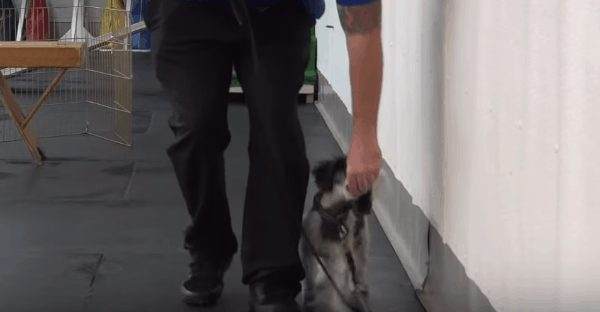
I kind of wait him out a little bit. I want to make sure that he understands that he was only going to be rewarded with all four feet on the floor. Once you’ve had some success with your dog walking against that barrier, you can up the challenge for them a little bit.
#4 How To Use Jump Bars
I lay down some jump bars, but you could use a couple of leashes, or maybe it’s a chalk line on the driveway or a piece of rope or whatever. The reality here is that this definitive line is going to help you see that position as much as it is for your dog.
So, once you’ve had some success with some barrier walking, you can give this a try, with a little line on the floor. I practice this the exact same way as the last time with a wall.
Just keep in mind, when you’re walking with your dog, when you’re working on this maintaining position at your side, save the last treat for that beautiful sit-in at your side.
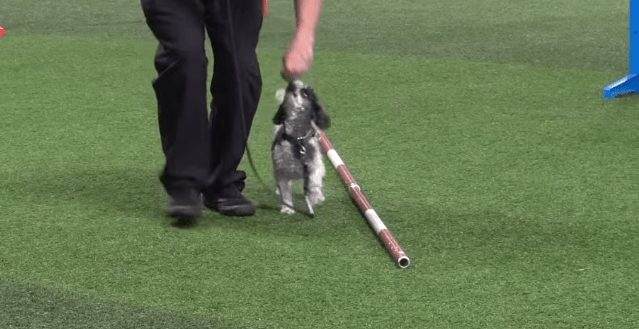
In case you want to know how to make a Dog agility jump bar at home then do watch the following video which we have shortlisted for you:
#5 Walking On a Loose Leash
Sometimes we’re our own worst enemy when it comes to teaching our dogs to walk calmly on a loose leash. If your dog really wants to go somewhere, the first thing you do is take him off leash so that he can play some agility. But identify this as a training opportunity.
So if you have a dog that loves to walk up to the park, maybe you walk up toward the park for 25 feet. Once he starts pulling, you turn 180 degrees around and reward your dog for walking away from the park on a loose leash.
It’s really important that you’re not accidentally rewarding them for the behavior that you’re trying so desperately to get rid of.
#6 Handling Outside Distractions
When trying to get your dog to walk calmly on a loose leash, there is another common challenge. This relates to distractions from another dog or another person when you’re on your walks.
The key is to be proactive, rather than reactive. You need to be proactive rather than waiting to see what your dog does when you encounter those people or that other dog. Give him something for paying attention to you.
You can get your spouse, or your friend, or maybe a neighbor with a dog and then practice this exercise.
Get them to stand still with their dog. That way it’s a little bit less distracting if your dog really loves to meet and greet other people and other dogs. But as we pass by them and as you pass by that tough distraction, feed your dog.
And really keep them focused on you. We want to make it a lot less interesting to check out those other dogs and those other distractions as we walk by being proactive. So that he pays attention to us rather than that distraction.
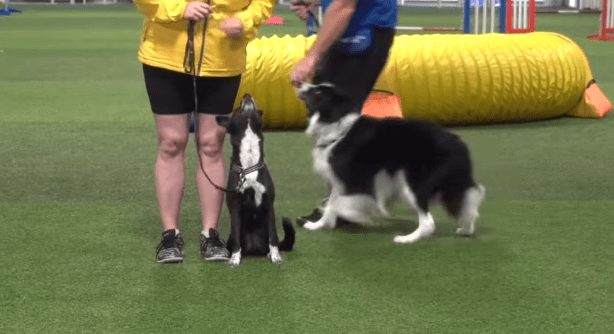
#7 Handling Distractions From Other Walking Dogs
The next way we’re going to challenge our dogs is by walking them by one another. We can keep dogs on the outside of us. We can make it a little bit easier and a little bit more likely for them to be successful by keeping them on the outside as we pass.
It just lessens that distraction a little bit. But it adds a little bit of challenge to the exercise.
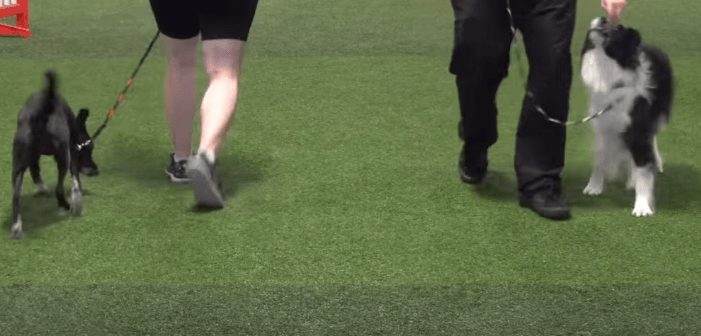
#8 Dog to Dog Exercise
Finally, we’re going to try it by walking dog to dog. Now, this is going to be really tough for some of your dogs at home. So make sure you pull out those really valuable rewards. You need to be really proactive about rewarding them before they get next to that dog that’s passing.
Bonus Tip
Now if you have a dog who is just completely beside himself. As these tough distractions go by, he’s not even paying attention to the food, then often working them in a stationary position can be really helpful.
Exact Leash Training Routine to Follow Every Day
Adding and repeating the following 7 steps every day will help your training sessions a lot:
- It is vital to hold up the harness. When the dog sniffs it, provide him with a reward. You should try to repeat this five times.
- Place harness over his back or neck and then provide dog with a treat. Repeat five times. Remember that treats should only be given when a harness is on.
- You should go ahead and lengthen the amount of time harness remains on your dog’s back, from one second to 10 seconds.
- On the harness, buckle one buckle and then reward. Then, buckle the second buckle and then provide a reward. You should repeat this several times.
- With the harness on, you should play a game of fetch or tug-of-war to distract the dog from the feeling of having a harness and being buckled.
- After a one-to-two minute play session, proceed to feeding dog with meal.
- When the dog finishes meal, remove harness.
How to Leash Train a Puppy
It is important to not forget that puppies are exploring the world, so you should follow the aforementioned routine, but you should not forget to stop when he wants to sniff, even if he is stopping every six inches.
Dealing with an Impatient Dog
It is quite common for dogs to feel impatient in the beginning, hence it is highly recommended to bring treats along while training. Of course, this type of incentive should only be provided constantly when training is being implemented.
When the dog has been fully trained, treats are also important, but not as much as it was in the beginning.
Talking to your impatient dog is crucial, as well as petting him. There might be times that this impatience is due to him wanting to get away because of digestion-related reasons.
So, it is important for a bond to be present between the dog and the owner. When there is one, training will be much easier because the owner will know what is wrong with the dog, most of the time.
Importance of Reducing Leash Size
When you have been training your dog for a few days, it is vital for the leash size to be reduced in size. Try one that is six feet. You can go ahead and take him to the street with you. If he is not moving as rapidly as you, do not opt to pull. Instead, you should walk in a slower manner and encourage your dog to keep going.
How Long Does Leash Training Take for Both Puppies and Older Dogs?
It is vital not to strain your dog with hours of training. It should be done for a few minutes every day. It will little by little become a habit. Puppies should have three-to-five minute training sessions, three-to-five times a day, while adult dogs should be trained 10 minutes, two-to-four times a day.
Every dog is different; thus, the time that it will take for training to conclude once and for all will vary; nonetheless, it is common for a dog to be fully trained within a week or two.
Key Points to Take Note on
- Pulling should not be rewarded: Never move in the direction of the pull.
- Reward loose lead walking: When being obedient and thus walking beside you, reward your dog.
- Do not add tension: If the dog is in the right position, the leash should be hanging loose.
- Do not punish: If the dog pulls, instead of punishing, provide positive reinforcement.
- Consistency is the key: Do not lack in the training. Keep being consistent with training routine in order for your dog to be properly trained.
Begin Training Your Dog Today!
Conclusion on How to Stop Dog Pulling on Leash
If you were skeptical about training your dog to walk on a leash without pulling, you should no longer be if you opt to take into account the previously mentioned information.
You would be well on your way to helping your dog stay at your pace right beside you when walking outdoors. Go ahead and see for yourself by training your dog today!
References
- https://utouch.cpsc.ucalgary.ca/docs/HowToWalkARobot-RoMan11-JY.pdf
- https://www.mdpi.com/2076-2615/6/5/34
Table of Contents

